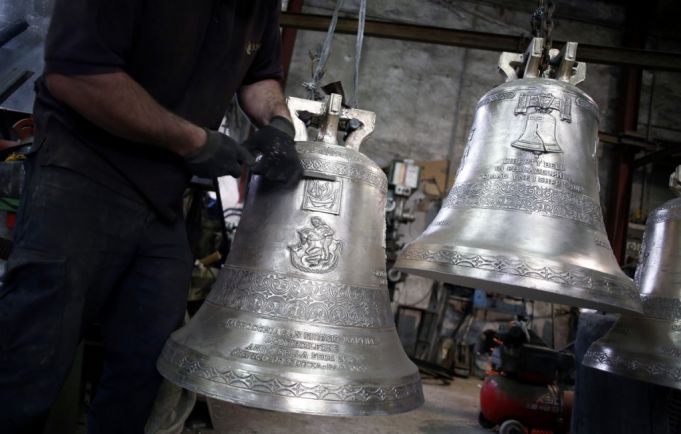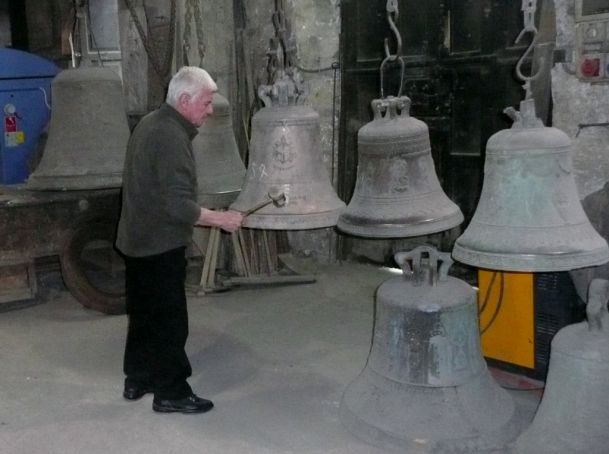The historic bell foundry in Agnone expects to play an important role in Pope Francis' special Jubilee of Mercy.
Margaret Stenhouse
The ancient town of Agnone, tucked away in the hidden heart of the Molise region, has been making bells for a thousand years. What is even more astonishing is that the same family has been producing bells continuously all that time, from generation to generation.
It is on record that a certain Nicodemus Marinelli began signing his bells around the end of the 13th century. The present Marinelli foundry, which dates back to 1339, is run by his descendents, the brothers Pasquale and Armando Marinelli, makes it among the oldest family industries in the world.
Marinelli's bells peal out in four continents – from Europe, from North and South America, from Asia as well as countries in the Middle East. In Italy, they toll at the sanctuary of the Madonna of Pompeii, the abbey of Montecassino, the Padre Pio shrine at S. Giovanni Rotondo and the Leaning Tower of Pisa – to mention just a few.
In Rome, they hang in the bell towers of the basilica di S. Paolo, the church of Trinità dei Monti atop the Spanish Steps, the church of S. Agnese in Agone in Piazza Navona and Richard Meier's spectacular modern church of Dio Padre Misericordioso at Tor Tre Teste, which was built to herald in the third millennium.
The foundry makes an average of 40 bells per year, but the special Holy Jubilee of Mercy proclaimed by Pope Francis is expected to increase demand. “Every bell takes at least a month of work,” explains Pasquale Marinelli. “So we can only cope with so many orders.”

They are already working, he says, on the design for a new commemorative bell for Rome's basilica di S. Maria Maggiore to mark the Jubilee, which started on the feast of the Immaculate Conception on 8 December and will end on 20 November 2016.
Not surprisingly, the Roman Catholic Church is the foundry's best client. In fact, the Vatican commissions around 90 per cent of Marinelli bells. Pope Pius XI bestowed official patronage on the Marinelli business in 1924, granting it the right to add the title “Pontifical” and allowing it to display the Vatican cross keys over its entrance.
Casting a bell is a long and delicate process. Master bell-maker Antonio Degli Quadri, who has been working at the foundry for 54 years, took us through the process, which has remained basically unchanged over the centuries.
“The first step is to construct the anima,” he explained. “That's the basic bell shape built of bricks. Next you use clay to mould the falsa campana (false bell) around the anima and you apply the decorations and dedications in hard wax. After that, you create the mantella by spreading layers and layers of clay over the falsa campana to make a shell of the required thickness.”
Following the time-honoured “lost wax” process, the fledgling bell is heated to melt the wax, leaving the designs impressed in negative on the mantella. The false bell is then removed and the mantle placed back over the anima ready for casting. The molten bronze (composed of an alloy of 78 parts copper and 22 parts tin) has meanwhile been fired up to a temperature of 1,200° C in an open pit in the workshop floor. The incandescent liquid is poured through an opening left at the top of the mould to fill the space between the mantella and the anima.
A few days later, when the bronze has set, the fledgling bell is hoisted up and the clay mantle chipped off to reveal the shining new-born bell. The birth of a bell is a solemn and reverent moment because bells are traditionally considered sacred objects. Frequently a priest is present to recite a prayer, and many of the bells have been blessed by popes. On his pastoral visit to Molise in July 2014, Pope Francis was presented with two bells, one of which was gifted to Campobasso prison, while the other was sent to a penitentiary in Argentina.
The Historical Bell Museum adjoins the workshop and was dedicated to Pope John Paul II, who visited in 1995. The main gallery contains hundreds of bells, many of great antiquity, with pride of place given to the venerable “Bell of the Year One Thousand”.
The bell-makers of Agnone inherited their art from their ancient ancestors, the Samnites, who had a long tradition in metal-working. A reproduction of the third-century-BC Tabula Osca, a unique bronze tablet inscribed in Ocsan, the Samnite language, is on display. The original tablet, which contains dedications to various deities but no references to bells, is in the British Museum.
Famous Marinelli bells include the five-ton Great Bell made for the 2000 Jubilee, now in the Vatican gardens, the Celebration Bell for the 150th anniversary of the unification of Italy, the Mundial Bell commemorating Italy's football World Cup victory in Spain 1982 and the 1998 Bell of Peace in Tirana, made at the end of the Balkans conflict from shell cases gathered by Albanian children.

Some bells have the sad job of honouring the dead, such as the Bell of the Marcinelle mine in Belgium, where 262 miners were killed in 1956, the Bell of the Angels in S. Giuliano di Puglia, where 27 elementary school children perished in an earthquake in 2002, and the Nicholas Green Bell at Bodega Bay, San Francisco, engraved with the name of the seven-year-old boy who was shot dead in a robbery attempt while on holiday in Italy with his parents in 1995.
Our tour ended with a grand finale, when Antonio Degli Quadri treated us to a bell ringing recital with a concert of bells suspended in a row along one side of the foundry. The success of a bell depends, of course, on its tone and this is a finely calculated mathematical operation. Depending on its weight, diameter and height, each bell will ring a particular note on the musical scale. It is almost magical to hear a concert of bells produce an amazing range of harmonies and sounds under the hammer of a skilful bell-ringer. We listened entranced as Degli Quadri conjured up a selection – from Mozart to the Godfather theme.
The Historic Bell Museum, Via Felice D'Onofrio 14, 86081 Agnone (Isernia), gives guided tours every day from midday to 16.00, Sun midday-13.00, with additional tours in August. Sunday afternoons closed. Reservations necessary for groups.
Tel. 086578235, email info@campanemarinelli.com or see website.
SIDE NOTES
The Marinellis are considered Italy's oldest family business and among the three oldest family firms worldwide.
During world war two, the fascist regime ordered that church bells across Italy be melted down to produce weapons. Although many Italians defied authorities by hiding or burying their local church bell, by the time the armistice with the Allied forces was signed on 8 September 1943, thousands of bells had been requisitioned as part of the war effort. The northern diocese of Bergamo alone registered the loss of 1,224 bells. The post-war years signalled a boom for the Marinelli foundry, which struggled to keep up with demand from Italy's reconstructed and newly-built churches.
The foundry represented the Molise region at the Expo Milan 2015 with an 850-kg bronze bell bearing the Expo logo as well as the crests of Milan, the Molise region and the municipality of Agnone. The bell was decorated with images of the Ndocciata, an ancient festival of fire which takes place each Christmas in Agnone. It also featured a representation of S. Francesco Caracciolo, the patron of Italian chefs, who died in Agnone in 1608 and was proclaimed a saint two centuries later.
This article was published in the December 2015 edition of Wanted in Rome magazine.

















